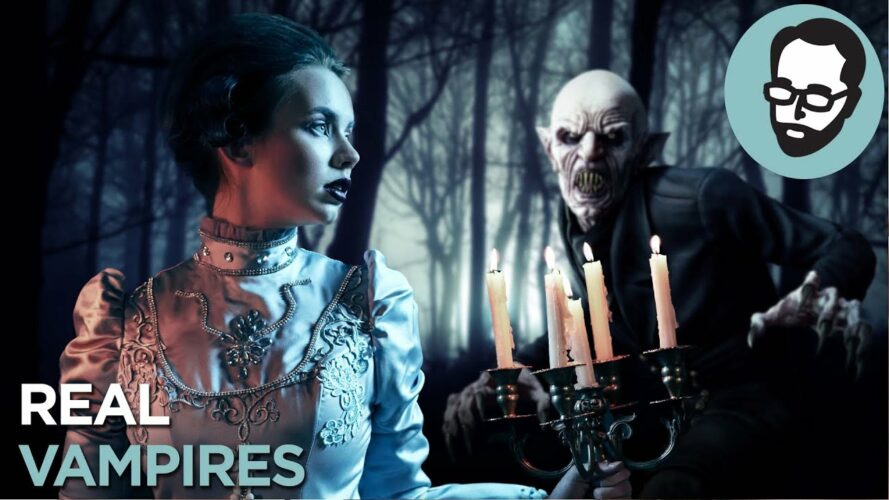Vampires have been a part of folklore for hundreds of years, but in parts of New England in the 18th and 19th centuries, they were a very real. Let’s talk about the New England Vampire Panic.
TRANSCRIPT:
This is Salem Massachusetts, which famously got caught up in a witch craze in 1692 that led to the executions of 19 people. It was a society gone mad, overcome by fear and superstition. And it’s not the last time this happened.This is Salem Massachusetts, which famously got caught up in a witch craze in 1692 that led to the executions of 19 people. It was a society gone mad, overcome by fear and superstition. And it’s not the last time this happened.
In fact, 200 years later in 1892, you get the story of Mercy Brown.
Mercy Brown was the unassuming daughter of George Brown, a Rhode Island farmer whose life had just been through a series of tragedies.
Tuberculosis had been ravaging the area, they called it “consumption” at the time and in this outbreak George lost his wife Mary, his daughter, Mary Olive Brown, and in the same year Mercy Brown herself died of the illness.
And even as he was burying Mercy, his son Edwin became sick.
But if Mercy’s life had been unassuming, her death would be nothing of the sort.
Because two months later, a mob of people from the town of Exeter dug up Mercy’s body, pulled out her heart and set it on fire.
Mercy unfortunately got caught up in a Salem Witch style mass hysteria event that took place in New England in the late 1800s. Only they didn’t think Mercy was a witch… They thought she was a vampire.
Just to put that time period into perspective, this was the 1890s, the Gilded Age, we had lightbulbs and telephones, transatlantic steamships… Mercedes had its first car on the road at this point.
We even had the germ theory of medicine, though it was still in its early days and hadn’t been universally adopted. In a lot of areas the old folk remedies and superstitions held sway.
And rural New England was one of those places.
By the way, Mercy Brown was not an isolated event, another story involves Rachel Harris of Manchester, Vermont.
This was about 100 years earlier in 1790, but Rachel died from tuberculosis. Her husband then married her stepsister, Hulda, who also started to show signs of TB.
And yeah, the local townspeople thought that it was Rachel’s fault. That she was escaping her grave at night and enacting revenge on her stepsister.
So they exhumed Rachel’s corpse in February 1793. They removed her heart, liver, and lungs and burned them on a blacksmith’s forge.
This was a big event by the way, 500 people showed up to take part in this. In fairness, there probably wasn’t a whole lot else to do in 1793 Vermont.
Regardless, despite their valiant efforts, it didn’t stop Hulda from dying in September of that year.
So, this was a real thing, people were really convinced that vampires existed and preyed on the living.
But these aren’t exactly the vampires we think of today. Today we’ve seen vampires imagined in just about every way possible, from Count Dracula, to Edward Cullen from Twilight, and Grandpa Munster from The Munsters.
But all vampires in fiction have a few core characteristics in common:
- They drink human blood
- They can turn their victims into vampires
- They prey on their victims at night because the sun kills them
- They have hypnotic powers
- And they can’t see their images in mirrors and have no shadows.
Of course a lot of what we now think of as a vampire was first popularized by Bram Stoker when he wrote Dracula in 1897.
He was the first person to take all these folk stories about vampires and codify them in a way.
It’s thought that he named the character Dracula after Vlad III, who ruled an area of modern day Romania called Wallachia from 1456-1462.
His father was Vlad the second, who went by Vlad Dracul, meaning Vlad the Dragon. So Vlad the third was called Dracula.https://en.wikipedia.org/wiki/Vlad_the_Impaler
He was also called Vlad the Impaler, because he got a kick out of impaling his enemies on wooden stakes.
And it was also said he enjoyed dining among his dying victims and would dip his bread in their blood. Which is horrifying… And really unsanitary.
Another historical figure that may have inspired Bram Stoker is a Hungarian countess named Elizabeth Báthory.
If you’ve never heard of Elizabeth Báthory, it’s probably because she KILLED EVERYONE WHO MET HER.
It’s rumored that she tortured and murdered more than 600 young women during the 16th and 17th centuries. And she would even bathe in the victim’s blood.
It should be noted that these accusations may have been politically motivated and completely untrue, but they tied into beliefs that people already had about monsters drinking the blood of others.
These stories go back to the middle ages as plagues began to spread throughout Europe. People didn’t know what was going on, and often turned to folk takes and the supernatural to explain it.
For example, some of the victims of the plague had mouth lesions that bled, and some thought that their mouths were bloody because they were drinking other people’s blood.
The point is there are a few diseases that historians think were related to vampire stories.
The first one isRabies
In 1998, neurologist Juan Gomez-Alonso published a paper in Neurology that argued the symptoms of rabies might explain vampire myths. https://n.neurology.org/content/51/3/856
Rabies lyssavirus causes rabies in animals. It’s transmitted through direct contact with saliva or brain/nervous tissue from an infected animal.
Rabies infects the central nervous system. Once it reaches the brain, it can cause things like agitation, anxiety, confusion, and hallucinations before killing the victim.
Yeah, have you ever really looked into rabies? Rabies SUCKS.
People with rabies… go rabid. They bite and scratch and claw at people like a wild animal.
Seeing a person do that might put some ideas in your head.
The article also mentions that people who die from rabies often die from suffocation or cardiorespiratory arrest.
This can make the blood less likely to coagulate and slow the decomposition, which to some people might look like the dead person is more undead than dead.
He also pointed out correlations in rabies outbreaks and the birth of vampire tales in the 1720s in Eastern Europe.
But another contender is Porphyria
So, rabies may explain the biting and scratching parts of vampire lore, but other characteristics could be explained by a blood condition called porphyria.
For people with porphyria, their bodies don’t make heme, which is an essential part of hemoglobin, that’s what carries oxygen in our blood.
There are two, broad types of porphyria:- Acute porphyrias which affect the nervous system- Cutaneous porphyrias that affect the skin
The most common type of acute porphyria is acute intermittent porphyria, which causes sudden and painful attacks.
These attacks may include seizures, breathing problems, and red or brown urine. (which one might expect one’s urine to look like if one were drinking a lot of blood)
And these attacks are often set off by triggers, including stress, medications, and sunlight.
Similarly the skin porphyria is set off by sunlight and can cause blisters or excessive hair growth
Porphyria cutanea tarda (PET) is the most common form of cutaneous porphyrias. It is characterized by extreme sensitivity to sunlight.
If exposed to sunlight, people with PET might experience skin blisters, excessive hair growth, and red or brown urine.
So… They’re burned by sunlight, so they only come out at night, and they have red pee. Like they’ve guzzled so much blood, their urine is red.
And actually one of the treatments for porphyria was to drink animal blood.
People have even speculated that repeated porphyria attacks may cause facial disfigurement and gums to recede, leading to the teeth having a “fanged” look.
Oh, and believe it or not, garlic has a high sulfur content, and thus can make it a potential trigger for a porphyria attack.
So there’s a lot of interesting connections there, and I definitely could see people mistaking that disease for vampirism, but I don’t think that’s where it all came from.
Porphyria is a very rare disease so it’s unlikely that all the vampire myths came from the very few people walking around with that. However, seeing someone like that back in the day may have reinforced any belief they had.
But the disease that’s most associated with vampires is Tuberculosis
Tuberculosis is especially associated with the New England vampire beliefs in the 18th and 19th centuries.
A bacteria called Mycobacterium tuberculosis causes TB, which destroys lung tissue and can be fatal if not treated properly.
People who experience untreated TB lose weight, become weak, have fevers, and can cough up blood.
It basically makes a person look like blood is being slowly drained out of their bodies, like they wake up every morning a little bit paler than the day before. Like something it taking it from them in the middle of the night.
TB can also spread from person to person through the air, but most people back then didn’t know how that worked.
So, it’s no wonder they may have thought a supernatural creature was sucking the life out of those dying from TB. And usually that creature was someone who had recently died.
By the way, while we’re at it, there are other supernatural myths that may have a disease to thank.
Werewolves
Werewolves may have also been inspired by rabies for all the reasons I listed before, there’s also a a condition called lycanthropy that makes people hallucinate that they are a four-legged animal.
There is also hypertrichosis, which in some types causes hair to grow all over a person’s body, giving them a little Teen Wolf flavor.
Witches
Witches are sometimes associated with ergot poisoning, which is a wheat fungus that can cause manic episodes and hallucinations.
But in the case of the vampire craze in 18th and 19th century New England… It was TB.
A disease that so appears to consume the body that they actually called it Consumption. It’s easy to see why one might suspect it’s something else consuming the body. Maybe someone who had just died. Someone like Mercy Brown.
As tuberculosis ravaged nearby Exeter, the townspeople began to suspect things, maybe out of desperation. They started looking around for patterns.
And while everybody had suffered in this outbreak, maybe none more so than George Brown, who had lost is wife, his two daughters, and now his only son was sick as well.
I can only imagine that when some of the townspeople came to visit, shovels in hand, insisting on digging up his family, George was just too exhausted to object.
They dug up his wife Mary and older daughter Mary-Olive, but they had deteriorated to the point it wasn’t possibly them. But Mercy, who had only been in the ground for 2 months in the winter… looked remarkably fresh. In fact, her hair and nails seem to have grown a little and blood still pooled in her body.
So they did the thing the folk tales say to do… they took out her heart, burned it and mixed the ashes into a potion for Edwin to drink. This would hopefully cure him of the vampire curse.
It didn’t. He died a few months later.
The Mercy Brown story did make some headlines and in fact, clippings of these articles were found in Bram Stoker’s files after he died, so he did know about it and may have even been inspired by https://newengland.com/today/living/new-england-history/vampire-mercy-brown-rhode-island/
The vampire panics started to die down in the 20th century when medical knowledge improved and tuberculosis became treatable with antibiotics. In fact Mercy Brown was one of the very last “confirmed” vampires in America.
The vampire panics started to die down in the 20th century when medical knowledge improved and tuberculosis became treatable with antibiotics. In fact Mercy Brown was one of the very last “confirmed” vampires in America.
Today, her gravesite is a tourist attraction. Visitors to her grave may see gifts left behind, like jewelry and flowers.
Or in one case, a note that just said, “You go, girl.”




Add comment